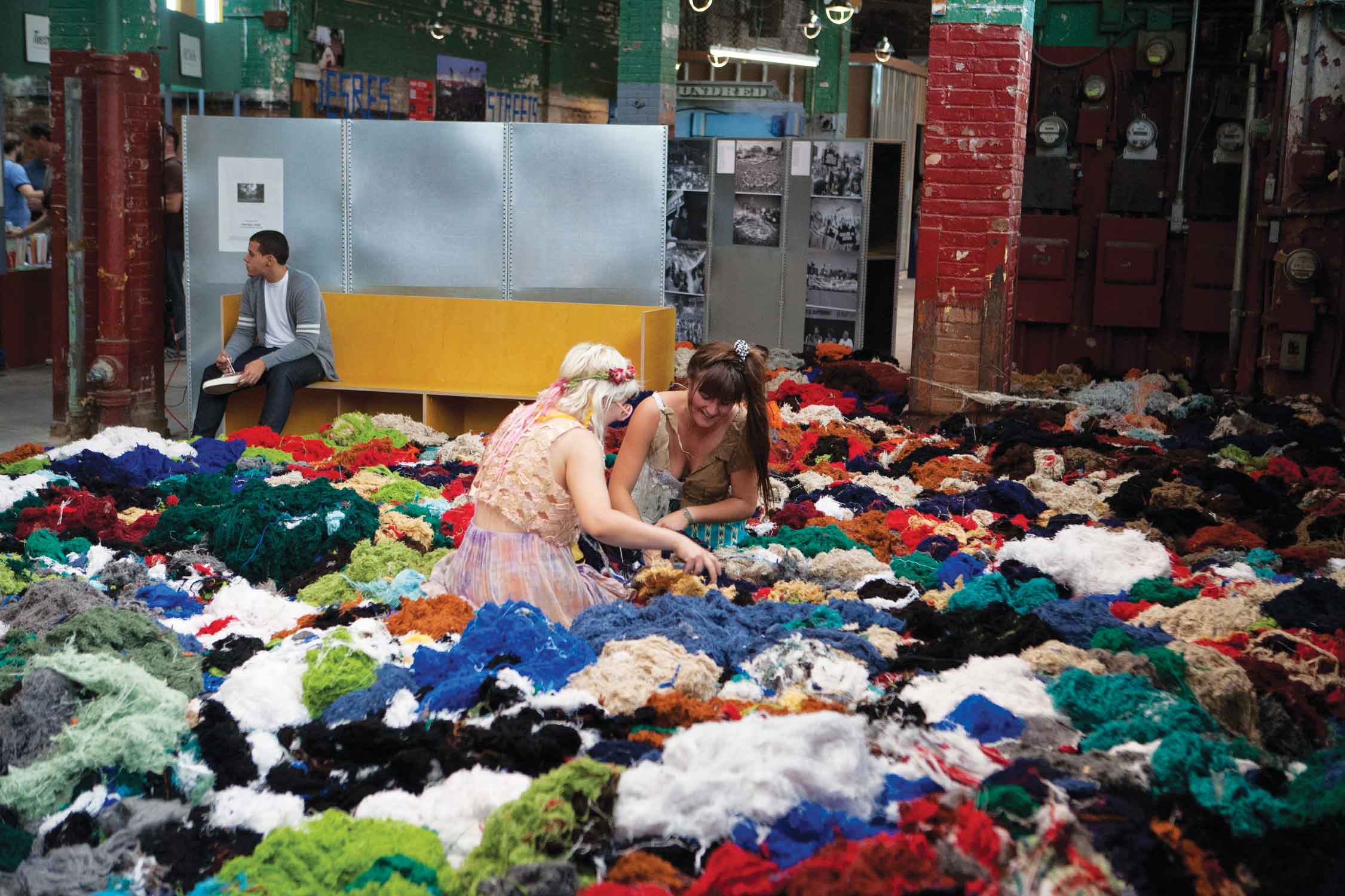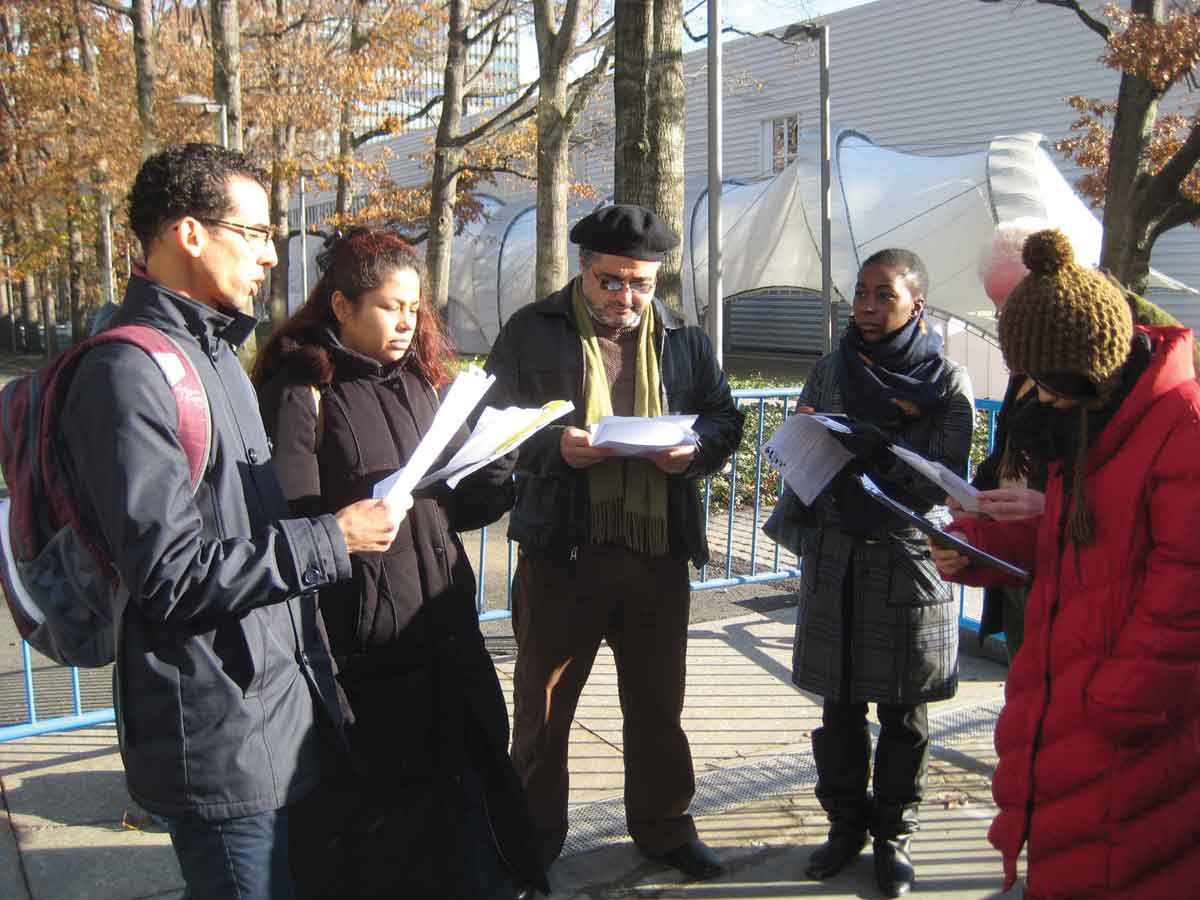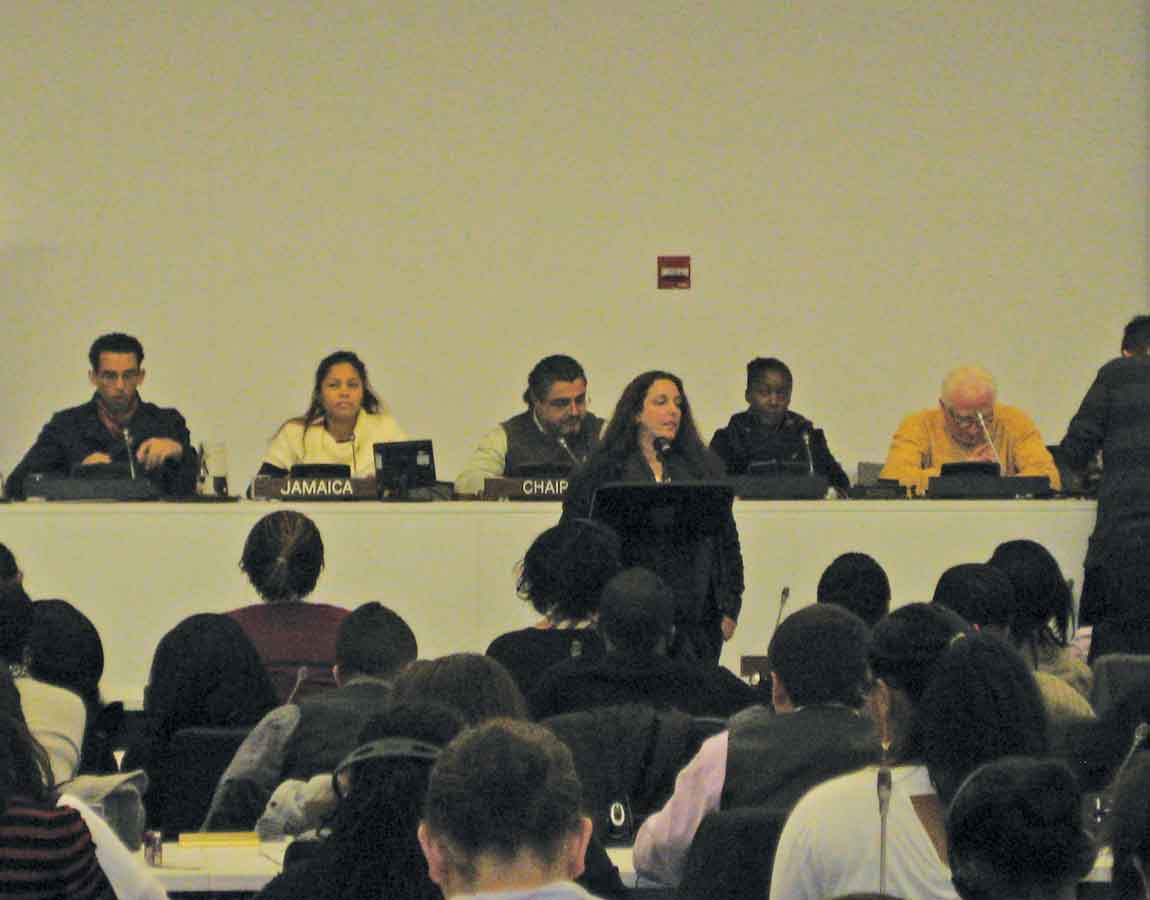« Features
Considering Activist Art in the Age of Occupations

Image War on the Pentagon, PAD/D's protest art works designed for anti-war demonstration held in Washington DC in 1981. Photo: Courtesy of Gregg Sholette personal archive.
By Carla Acevedo-Yates
Can art instigate social change? What can previous attempts to produce activist art teach us? It is a difficult task to assess the social and political impact of activist art. But perhaps the questions that arise with the proliferation of these practices are more important than any answers we can find.
FROM CHANGE TO OCCUPY
Barack Obama’s 2008 presidential campaign slogan made constant use of the word “change” to imbue hope into the minds and hearts of thousands of Americans who, finding themselves in the midst of a widespread economic crisis and seduced by mass media images, placed their dreams of a better future in his hands. Today, the previously ubiquitous word “change” has been replaced with “occupy,” a rebellious and defiant word that, in the face of increasing joblessness and financial corruption, has provoked many to take to the streets in active protest. And it has certainly been a time of change, but hardly the one envisioned back in 2008. The year 2011 was a momentous year for social unrest, one in which unprecedented social movements took place. What started as a regional political protest in the Arab world, now commonly known as the Arab Spring, snowballed into a worldwide movement, or “democratic awakening,”1 that has commanded international attention from politicians, artists, theorists and institutions. The truth is, as global citizens, we can no longer ignore the public’s general malaise with a capitalist structure that privileges corporate interests over social welfare.
Parallel to this cross-cultural organization for social change, artistic practices that intend to assume a social responsibility are on the rise. In New York City, two projects offer a starting point for discussion: Immigrant Movement International, initiated by visual artist Tania Bruguera; and Living as Form, curated by Nato Thompson, Chief Curator at Creative Time. These projects are by no means innovative initiatives in visual practice, as we shall see later on, as activist art practices in New York City emerged in the 1970s and continued well into the 1990s. But things have changed since then. The institutionalization of activist art and its increasing status as a social experiment raises important questions regarding its limitations, long-term sustainability and impact. One question to consider is to what extent are artists-activists simply just theorizing their practice as opposed to developing practical, hands-on activism through public policy modification. Additionally, have these practices, as well as democratic politics, become a sweeping ad campaign? Whose interests do these practices really serve, and how useful are they to the communities they intend to assist?

Living as Form, curated by Nato Thompson, installation view. Photograph by Sam Horine. Courtesy Creative Time.
THE AESTHETIZATION OF POLITICS AND THE POLITICIZATION OF ART
There is an undeniable utopic dimension to activist art projects, one that is firmly based in Marxist ideals. With the inception of the avant-garde during the early 20th century, notably the Constructivist project in Russia, Futurism and Dadaism, there emerged the idea of the artist as a social worker, a role that allowed artists to occupy a “useful” place in society. Today’s “committed” practices still maintain the utopic spirit of Modernism but have developed to become highly ambitious projects that aim at social and political change. In essence, their goal is to change the world, or at least make it a better place to live in. But in order for this to be manifest, for art to be truly useful, it must infiltrate the political sphere. Critic Boris Groys argues that art has already entered the political sphere many times to find that politics has been aestheticized, that it has already adopted the aesthetic mechanisms of visual practice.2 Conversely, we can also affirm that political mechanisms have entered the art world through the institutionalization of artistic practices. But what are the implications of the aesthetization of politics, and how can art truly function in the political arena?
In Walter Benjamin’s The Author as Producer, the idea of the artist as social worker is transformed into a question of production. In it, Benjamin argues an emphatic critique of “left-wing bourgeois intellectuals” in Germany during the 1920s and early 1930s, mainly the Neue Sachlichkeit and a group of writers and critics who were associated with the publicist Kurt Hiller, whom Benjamin defined as the “theoretician of activism.” Although the word “activist” at the time when Benjamin wrote the essay did not have the same meaning as it does today, the ideas that form the basis of the text provide an interesting framework from which to analyze today’s activist practices, mainly the difference between tendency and technique, or, in other words, ideas and actions. Parting from this theoretical framework, are today’s social practices bourgeois undertakings of a proletariat problem? And if they are, to what extent are artists assuming a position or a tendency (as Benjamin would argue) instead of focusing on actions to insert themselves into the modes of political production? Although perhaps many artists have attempted to take on social or political problems in their practice, in what ways do they become merely presenters of a social problem instead of agitators? How much of it is a simulation of “real world” activism or just amateur social work? (de Cauter, 16).
CASE STUDIES IN ART ACTIVISM
Art activism in New York has a riveting history that includes artist-driven initiatives that were seldom funded by art institutions or the government. These practices acutely began to manifest themselves during the 1970s with the Art Workers’ Coalition (AWC) and Artists Meeting for Cultural Change (AMCC), among others. However, whereas these practices focused their efforts on the demands of artists towards arts institutions and international movements such as the anti-war movement, activist art practices that emerged during the 1980s sought to provoke change outside the parameters of the art world, working with local communities and engaging in participative practices with other disciplines. During this time, two collectives surfaced on the Lower East Side of Manhattan, which marked an important precedent for today’s activist art practices: Group Material and Political Art Documentation and Distribution (PAD/D). The latter started as an archive of socially committed art practices with the impulse of Lucy Lippard, who initiated an open call to assemble an archive of art with political intent on the back of an exhibition invite for Artists Space. The group, which included former members of other activist organizations from the 1960s, turned into an art collective that emphasized connecting artists with activists through public dialogues, manifestations and art projects, participating in protests with visual pieces such as Image War on the Pentagon, used during a demonstration in Washington, D.C., in 1981. However, by 1985 PAD/D had lost considerable ground “when a prudent version of ‘political art’ became institutionally viable within the art world.”3 To this, Gregory Sholette, one of PAD/D’s founders, adds, “PAD/D had not survived the demise of an ever more factionalized Left with which, in hindsight, the group had too closely identified itself, and on the other hand Group Material’s accommodation by the art world ultimately lead to the collective in its last project to sardonically debate the very practices that it (along with PAD/D and many others) had once fought to establish.”4

Surasi Kusolwong, Golden Ghost, installation view at Living as Form. Photo: Sam Horine. Courtesy Creative Time.
Both Group Material and PAD/D share a number of similarities with activist art projects in New York City. A case in point is Immigrant Movement International (IMI) - a five-year project initiated by the Cuban-born performance artist Tania Bruguera- whose mission is “to help define the immigrant as a unique, new global citizen in a post-national world and to test the concept of arte útil, or “useful art,” in which artists actively implement the merger of art into society’s urgent social, political and scientific issues.”5 IMI additionally aspires to be an international political movement, an undertaking that already seems of quixotic proportions. Funded by Creative Time and the Queens Museum of Art in its first year, IMI opened a storefront in Corona, Queens (one of the most culturally diverse neighborhoods in New York City), where a group of volunteers offer free services to the local immigrant community (from English courses to legal advice), while hosting a number of discussions on art- and non-art-related issues.
But however promising this may all sound, IMI’s long-term sustainability as well as social and political impact is questionable. At the moment, Bruguera has only secured funding for the project’s first year. The fact that IMI is an itinerant project-its headquarters will be moved to different cities around the world for the next four years-poses questions regarding its long-term commitment to local communities. Also, the question remains as to what will happen to the people used to having this resource once the storefront closes. Although IMI works with grassroots organizations that are familiar with the neighborhood’s immigrant constituents and the problems they face on a day-to-day basis, what is IMI bringing to the table? And what is gained from the aesthetization of immigration? For the time being, the project falls flat for being overly ambitious and assuming a presumptuous position towards the local community. By dedicating only one year in Queens to such a complex issue, the project sadly ends up looking more like a social experiment than a committed art practice.

Tania Bruguera. Immigrant Movement International. First public reading of the Migrant Manifesto. United Nations Students Conference on Human Rights. December 2, 2011. Courtesy IMI.
Insofar as Living as Form is concerned, the project also presents some timely questions regarding activist art and the experience it provides for viewers. The exhibition, presented in the historic Essex Street Market, was confusing at best. For starters, it was difficult to understand where most of the art was. Apart from works such as Palas por Pistolas by Pedro Reyes, which garnered much attention for its measure of both aesthetic criteria and social utility, most projects were visually non-existent, diluted and reduced to pamphlets and texts accumulated on shelves, which were far too many for anyone to read in one visit, or even several ones. Although the project did succeed in continuing an archive of social practices initiated by PAD/D in the 1980s, questions continue to arise regarding the “active” component immanent in activist art. How capable are projects such as Living as Form in turning spectators into social activators or agitators? Are viewers expected to take part in the action or stand merely as consumers of activism? How can audiences be transformed from viewers into actors, from consumers into producers? If this question is not of utmost importance, then what is the point of activist art? The fact is, Creative Time, under the curatorial direction of Nato Thompson since 2007, has an ambitious if not overly romantic vision of social practice (and contemporary art) that seems too attached to a branch of relational aesthetics that already looks like it is from another epoch.
BETWEEN IDEALISM AND CONTRADICTION
In many respects it would seem that some artists who aspire to be activists assume a rather comfortable position in regards to the issues they confront. As artists, and not social workers or activists, there is a lingering possibility of falling back into a purely aesthetic practice completely detached from social commitment. In what ways are these artists “ideological patrons” or “benefactors” of specific causes as opposed to producers of change? (Benjamin) And to what extent do these projects run the risk of diluting themselves with institutional or careerist interests? An important discussion of this subject is offered by Gerald Raunig in his essay “The Author as Traitor.” If the intellectual’s solidarity with the proletariat can always only be a mediated solidarity, then the intellectual, who has become a bourgeois intellectual due to social and educational privilege, must become, according to Benjamin, a “traitor to his original class.” To betray one’s class, Raunig argues, would entail “dropping out of the framework of representation” altogether.6
In 2008, Shepard Fairey made a poster that became one of the most iconic images of the Obama presidential campaign: a stylized portrait of Obama with the word “HOPE” figuring predominantly in bold letters. Although initially Fairey produced and distributed the images by his own means, it was subsequently approved by the Obama campaign and utilized for marketing purposes. Last year, Fairey produced an interpretation of his poster for the Occupy movement, in which he replaced Obama’s face with the infamous Guy Fawkes mask and the words “Mr. President, we HOPE you’re on our side.” This oppositional shift is a prime example of how quickly hope can turn into doubt, art into propaganda, and activism into advertising. Activist art has long been institutionalized and instrumentalized, and politics has found a comfortable place in the aesthetic realm.

Tania Bruguera. Immigrant Movement International. First public reading of the Migrant Manifesto. United Nations Students Conference on Human Rights. December 2, 2011. Courtesy IMI.
But what is the relationship, if any, between today’s activist practices and the Occupy movement? Despite producing the splinter movement Occupy Museums and the integration of the movement’s agenda into some socially engaged practices, there seems to be a huge gap between them. Although they both may have social or political agendas, movements such as Occupy are more effective in commanding the public’s attention to economic and political issues, even if their motives and mechanisms are highly debated. Committed artistic practices can ride the occupation wave but ultimately succumb to their own limitations; it’s efficacity counterbalanced by movements or organizations with greater visibility and impulse to demand public policy modification. Viewed in this light, activist art becomes a site-specific and ephemeral micro action in the larger panorama of social work and activism. The fact remains, activism does not entail solely a desire to change, but it inherently implies an action that is continuous and sustainable in the face of impending challenges. It is not ephemeral, and it does not have an expiration date.
NOTES
1. The Occupy movement was described by social theorist and activist Cornel West as a “democratic awakening,” a definition that has stuck through the movement’s development.
2. In Art Power, Boris Groys argues that art is used in two ways, either as a commodity or as a tool for political propaganda.
3. Gregory, Sholette. “News from Nowhere, Activist Art and Arter, a Report from New York City by Gregory Sholette.” gregorysholette.com. N.p., n.d. Web. 23 Nov. 2011. <http://gregorysholette.com/writings/writingpdfs/13_newsfrom.pdf>.
4. Ibid. In 1985 Group Material was invited to participate in the Whitney Biennial.
5. “About the Project | Immigrant Movement International.” Immigrant Movement International. N.p., n.d. Web. 13 Jan. 2012. <http://immigrant-movement.us/about/>.
6. Raunig, Gerald. “The Author as Traitor.” republicart I main. N.p., n.d. Web. 13 Jan. 2012. <http://republicart.net/disc/aap/raunig07_en.htm>.
REFERENCES
- Benjamin, Walter. “New Left Review - Walter Benjamin: The Author as Producer.” New Left Review. N.p., n.d. Web. 13 Nov. 2011. <http://mx1.newleftreview.org/?view=135>.
- Cauter, Lieven De., Ruben De. Roo, and Karel Vanhaesebrouck. Art and Activism in the Age of Globalization. Rotterdam: NAi, 2011.
- Groys, Boris. Art Power. Cambridge, Mass.: MIT Press, 2008.
- Raunig, Gerald. “The Author as Traitor.” republicart I main. N.p., n.d. Web. 13 Jan. 2012. <http://republicart.net/disc/aap/raunig07_en.htm>.
- Sholette, Gregory. “News from Nowhere, Activist Art and Arter, a Report from New York City by Gregory Sholette.” gregorysholette.com. N.p., n.d. Web. 23 Nov. 2011. <http://gregorysholette.com/writings/writingpdfs/13_newsfrom.pdf>.
- Sholette, Gregory. “A Collectography of PAD/D. Political Art Documentation and Distribution: A 1980’s Activist Art and Networking Collective.” gregorysholette.com. N.p., n.d. Web. 10 Nov. 2011. <http://gregorysholette.com/writings/writingpdfs/14_collectography.pdf>.


































